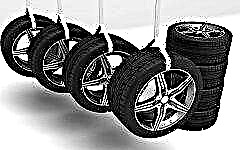

The content of the article:
- General storage requirements
- Storage with or without disks
- We store tires at home
- Influence of various factors on tire safety
Changing the season twice a year forces car owners to change the type of tires from summer to winter and vice versa. However, the question arises about storing tires for the period when they will not be used - can they simply be folded in the corner of the garage and forgotten for 4-5 months, or are there any nuances that do not allow this type of storage?
Unfortunately, many car enthusiasts do not pay much attention to this issue. But the wrong choice of the way of storing tires can lead to deterioration of their properties and technical parameters. This is especially true of winter tires, because in winter the safety of all road users depends on their quality properties.
General storage requirements

- It is necessary to mark each wheel indicating the installation location on the vehicle. If necessary, you can mark the outside and inside of the tire.
- Check pressure before storage (if the tire will be stored installed on the disk) with a pressure gauge, if necessary, bring its indicator to the values recommended by the manufacturer.
- Wash the wheel thoroughly after removing, inspect the entire riding surface. Remove stones and other foreign objects from the tread, make sure there are no cracks.
These requirements are the absolute minimum that must be met with every seasonal tire change.
Storage with or without disks

Many car owners are faced with the question - will it be correct to store tires on disks or is their removal a prerequisite? It can be argued unequivocally that both methods are acceptable, but there are a large number of nuances for each and them.
On disks
If this type of storage has been chosen, then the necessary requirements should be adhered to to prevent deformation and deterioration of the rubber properties. Under no circumstances should the tires be installed vertically on the rims. If space permits, you need to lay a pallet of wood on the floor, on which the wheels should be stored horizontally. It is allowed to stack them on top of each other.
Some car enthusiasts hang their wheels from the ceiling. This type of storage is permissible, especially when space is limited in the garage.
Without discs
For the diskless storage method, all the rules are opposite to those described above. It is forbidden to store horizontally, put tires on top of each other and hang them up.
Installation is allowed only in an upright position, and the rubber must be rotated every three to four weeks. A good solution would be to assemble a special rack that will be attached to the wall.
Ignoring these rules can lead to severe deformation of the tires and the subsequent impossibility of balancing at the tire fitting, that is, complete damage.
Home storage

How to store it is impossible
- On the balcony, if it is not glazed. This type of storage of tires is equivalent to street storage. Aggressive exposure to cold, wind, sun and moisture can cause permanent damage within three months.
- In the common apartment vestibule, on the landing and other places of mass passage of residents of the house. In addition to the inconvenience that the wheels will create, the fire safety requirements are also violated, since in the event of an emergency, the evacuation of people will be difficult.
- Near hot batteries, under flowing pipes, in cold unheated rooms. Such storage conditions will affect the quality of the rubber surface, which will subsequently lose its performance properties.
- On a floor with sharp edges or uneven surfaces. This will cause deformation and damage to the tire, which hi to the impossibility of its further use.
How can you store
- Glazed heated balcony apartments or houses.
- Dry storage room of the apartment. This is a clean and dry place without temperature extremes or exposure to sunlight. As a rule, pantries are dark, which is one of the positive factors for storing rubber. You just need to make sure that humid air and steam from the kitchen or bathroom does not get into the pantry. It is also not allowed to store various chemicals nearby.
- Heated garage. Chemicals must not be stored near the tires, and sparks and open flames must not fall on the rubber itself during work. However, if the garage is metal, then it is undesirable to store winter tires in it during the summer period, since in this case the effect of temperature differences is great - it is very hot in the garage during the day, and the temperature inside drops at night. Such vibrations will lead to cracking of the rubber.
- Dry cellar, if the temperature in it is more or less constant, and the humidity is within normal limits.
Influence of various factors on tire safety

When storing rubber at home, there are many factors that can affect its further condition.
- Indoor temperature. A feature of modern high-quality rubber is strict adherence to the temperature regime. Negative values are not recommended, however, it is not allowed above +25 degrees. For this reason, an unheated garage is not suitable, as is storage near radiators, heat guns and other heat sources.
- Sun rays. Their effect leads to drying and cracking of the rubber. Cracks during visual inspection may not be detected, however, if during the movement the wheel falls into a hole, then the likelihood that it will burst increases several times.
- Humidity. Storage of tires, both with and without disks, is allowed only in a dry room. It is not recommended to pack them in plastic bags, which create ideal conditions for moisture condensation. If tires are stored with discs, then the discs begin to rust. Special non-woven bags are commercially available for storing wheels, and a separate bag is required for each wheel.
- Chemical substances, of which there are a large number in any garage, have a destructive effect on tires. These substances are various oils, gasoline, acids.
- Deformation. With prolonged storage in one position, deformation of the rubber occurs. It is recommended to turn it over from time to time.
- Storage periods. The shelf life of a tire may vary depending on the composition of the rubber, but usually it does not exceed six years. After this period, the use of the tire becomes unsafe.
Compliance with all the rules listed above will help keep the rubber in good condition for many seasons, and its use will not lead to road accidents and other undesirable consequences.











